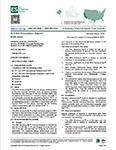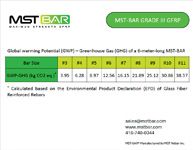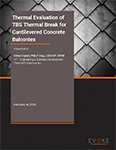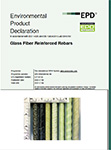MST BAR
Manufactured by MST Rebar Inc.
MST NYC OTCR Acceptance – #56-24
An indisputable leader in FRP rebar technology. We believe in one famous statement, “DO IT RIGHT, DO IT ONCE”.
We have worked for more than half a decade to develop an optimum product that have superior properties & overcome the limitation of available GFRP rebar in the market. With collaborations from the University of Sherbrooke & the University of Concordia in Canada, MST-BAR® is tested and proven to be the best GFRP rebar in the market.
The design of MST-BAR® delivers extremely high bond strength with concrete (3x the strength of steel) while providing the highest stiffness in a material.
MST Rebar Inc. is dedicated to getting MST-BAR to the job site, anywhere in the world.
info@mstbar.com to be connected to your local sales representative.


Contact Us to Learn More or Get a Quote
Documentation
FAQs
What method of calculation is used to compute foundation tensile strength and shear strength? Do ACI principles for reinforced concrete apply with modified material properties for fiberglass vs steel?
ACI 440.11-22, ICC AC454, CSA 806 are standards for Glass fiber rebar. We also have S-Concrete/ S-line software for design and can provide training.
What are the failure mechanisms (ductile vs brittle)?
MST-BAR is linear elastic to failure- however the failure point is 3x higher than steel so crushing concrete is always the mechanism. Technically it is brittle, but it is impossible to break the bar and it is always under concrete compression.
Are there any manufacturer-specific design guides and calculation templates we would need to follow?
Our engineers follow ACI 440.11-22, CSA 806, AASHTO-GFRP 2019, CSA S6, ICC AC 454. There are bunch of design manual available too.
How do splices / development length compare to that of steel rebar?
Splice: 40x diameter of the bar
Development length: around ¾ of steel. Because of lower passion’s ratio and extremely high bond strength for our CIR (continuous integral ribs) to concrete, MST can have a much lower development length. For #5 bar our test show that with 7’’ of embedment the bar will reach to 145KSI.
Can fiberglass rebar be installed together with steel rebar, if necessary?
Absolutely, attached are some pictures, there is not reaction or whatsoever.
How easy is it to modify fiberglass rebar in the field (cutting, splicing, bending, etc.)?
Cutting is extremely easy with a diamond blade/chop saw/ jigsaw. Splicing is extremely easy.
Minor bent +/- 5 to 10 degree is possible but not more than that. Shop drawing must be done properly to ensure to change in bent bars. Mixing some steel bent in case of emergency is also possible.
How does fiberglass rebar impact reinforced concrete unit weight? For steelreinforced concrete we typically use 145-150 lb./ft3. It could be detrimental to reduce the weight of some column footings where we are relying on dead weight to resist uplift.
Rebar in general is only less than 2% of the weight of the reinforced concrete. Changing it to MST will affect the final weight by 0.5% which is very negligible. Concrete weight is 98% of the weight of the structure so this is not a concern at all.
Assuming corrosion and weight are not an issue, how does pricing of fiberglass bar (manufacturing & installation) compared to that of steel-reinforced concrete (in terms of $ / yd3)?
Material is being sold by linear ft. or meter because it is 4x lighter than steel. We can show them how to do a quick estimation if they have the tonnage of their steel rebar.
They are not permitted to be used in any structure that requires a fire rating. That is, the fire resistance rating for structures constructed with GFRP is zero. The new ACI code 440.11-22, section 4.11.1, states this.
Absolutely incorrect! Even ACI mentioned EXCEPT ( I am a voting member at ACI), MST-BAR has been tested according to ASTM E119 for a full scale slab test and structure was able to handle over 3 hours of fire rating with minimum cover concrete of 1.5’’. we plan to repeat the test and get a UL certification.
These reinforcing bars have no ductility and may not be used in structures assigned to SDC B and above.
They are linear elastic to failure at 3x higher loading and the structure can have a huge deformation where the steel rebar is blown to dust at that point! Material is extremely deformable and has been tested in seismic loading. In fact, due to high tensile strength and lower strain they provide much better confinement than steel. Material can achieve high drift ratio and it is very well tested in seismic.
How complex are the structural calculations comparing with the typical steel reinforcing bars for all types of structural members.
Very simple. In fast ACI 440 is almost a copy paste of ACI 318 with some minor changes.
Claims of being “greener” than reinforcing steel might be misleading. Today, the reinforcing steel is made from at least 97% recycled material and GFRP is petroleum based, which requires a lot of energy to produce.
Being green is not about recyclability. 85% of MST is glass (silica- 100% Recyclable) and the other 15% is epoxy. Being green is about life to cradle. How much energy it takes to produce and how much carbon footprint it produces during production, transportation,
and service life? MST-BAR produce 75% less carbon footprint compared to steel and also recycling the concrete is MUCH easier as the rebar get crushed in the concrete which means no more big crusher and no more mega size magnet to remove the bar. GFRP will become part of the aggregate of the future concrete.
GFRP have not been time-tested like coated steel reinforcing bars, or galvanized bars, or stainless bars have. Any long-term adverse effects.
ASTM D7957 and CSA S807 includes durability testing under load and without load. Steel rebar will be dissolved in those conditions. We have many studies. Let’s think about it! If this material had no durability why DOTs such as FDOT, MDOT, ODOT and many other DOTs are specifying it in their bridge deck, barriers, seawalls? First bridge used Fiberglass was in 1986 and that bridge is still there with ZERO sign of degradation and ZERO.
GFRP being claimed as long-term corrosion protection material. Do we have any history to back it up.
Yes MANY and we can show you guys many studies where even Stainless-steel rust! But not MST.
Are these bars wrapped with some type of UV protection or how long can they be exposed to sunlight before degrading?
No, typically GFRP bars don’t have a UV inhibitor and should be covered if they sit more than 2-3 months under a Florida or Texas type of sun. There has also been lots of studies to show even if they degrade it is under 5%
Have you performed tests where the bars were sprayed with bond-protector and not cleaned before the pour?
There is absolutely no issue with any sort of reaction to MST-BAR. MST resin has a very high chemical resistance, (Epoxy based). The only chemical that could possibly damage the bar is hydrochloric acid at 80% concentration.







